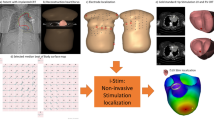Abstract
Electrocardiographic body surface mapping is used clinically to guide catheter ablation of cardiac arrhythmias by providing an estimate of the site of origin of an arrhythmia. The localisation methods used in our group produce results in left-ventricular cylinder co-ordinates (LVCCs), which are patient-independent but hard to interpret during catheterisation in the electrophysiology laboratory. It is preferable to provide these results as three-dimensional (3D) co-ordinates which can be presented as projections in the biplane fluoroscopic views that are used routinely to monitor the catheter position. Investigations were carried out into how well LVCCs can be converted into fluoroscopic projections with the limited anatomical data available in contemporary clinical practice. Endocardial surfaces from magnetic resonance imaging (MRI) scans of 24 healthy volunteers were used to create an appropriate model of the left-ventricular endocardial wall. Methods for estimation of model parameters from biplane fluoroscopic images were evaluated using simulated biplane data created from these surfaces. In addition, the conversion method was evaluated, using 107 catheter positions obtained from eight patients, by computing LVCCs from biplane fluoroscopic images and reconstructing the 3D positions using the model. The median 3D distance between reconstructed positions and measured positions was 4.3 mm.
Similar content being viewed by others
References
Burbank, F., Parish, D., andWexler, L. (1988): ‘Echocardiographic-like angled views of the heart by MR imaging’,J. Comput. Assist. Tomogr.,12, pp. 181–195
Calkins, H., Epstein, A., Packer, D., Arria, A. M., Hummel, J., Gilligan, D. M., Trusso, J., Carlson, M., Luceri, R., Kopelman, H., Wilber, D., Wharton, J. M., andStevenson, W. (2000): ‘Catheter ablation of ventricular tachycardia in patients with structural heart disease using cooled radiofrequency energy: Results of a prospective multicenter study’,J. Am. Coll. Cardiol.,35, pp. 1905–1914
Dodge, H. T., Sandler, H., Ballew, D., andLord, J. D. (1960): ‘The use of biplane angiocardiography for the measurement of left ventricular volume in man’,Am. Heart J.,60, pp. 762–776
Dove, E. L., Philip, K., Gotteiner, N. L., Vonesh, M. J., Rumberger, J. A., Reed, J. E., Stanford, W., McPherson, D. D., andChandran, K. B. (1994): ‘A method for automatic edge detection and volume computation of the left ventricle from ultrafast computed tomographic images’,Investigat. Radiol.,29, pp. 945–954
Dubuc, M., Nadeau, R., Tremblay, G., Kus, T., Molin, F., andSavard, P. (1993): ‘Pace mapping using body surface potential maps to guide catheter ablation of accessory pathways in patients with Wolff-Parkinson-White syndrome’,Circulation,87, pp. 135–143
Frangi, A. F., Niessen, W. J., andViergever, M. A. (2001): ‘Three-dimensional modeling for functional analysis of cardiac images: A review’,IEEE Trans. Med. Imag.,20, pp. 2–25
Gustavsson, T., Pascher, R., andCaidahl, K. (1993): ‘Model based dynamic 3D reconstruction and display of the left ventricle from 2D cross-sectional echocardiograms’,Comput. Med. Imag. Graph.,17, pp. 273–278
Hauer, R. N. W., Heethaar, R. M., de Zwart, M. T. W., van Dijk, R. N., van der Tweel, I., Borst, C., andBobles de Medina, E. O. (1986): ‘Endocardial catheter mapping: validation of a cineradiographic method for accurate localization of left ventricular sites’,Circulation,74, pp. 862–868
Hoekema, R., Uijen, G. J. H., van Erning, L., andvan Oosterom, A. (1999): ‘Interindividual variability of multilead electrocardiographic recordings: Influence of heart position’,J. Electrocardiol.,32, pp. 137–148
Leon, L. J., andHoráček, B. M. (1991): ‘Computer model of excitation and recovery in the anisotropic myocardium. II. Excitation in the simplified left ventricle’,J. Electrocardiol.,24, pp. 17–31
Nadkarni, S. K., Boughner, D. R., Drangova, M., andFenster, A. (2000): ‘Three-dimensional echocardiography: Assessment of inter- and intra-operator variability and accuracy in the measurement of left ventricular cavity volume and myocardial mass’,Phys. Med. Biol.,45, pp. 1255–1273
Nakagawa, H., Yamanashi, W. S., Pitha, J. V., Arruda, M., Wang, X., Ohtomo, K., Beckman, K. J., McClelland, J. H., Lazzara, R., andJackman, W. M. (1995): ‘Comparison ofin vivo tissue temperature profile and lesion geometry for radiofrequency ablation with a saline-irrigated electrode versus temperature control in a canine thigh muscle preparation’,Circulation,91, pp. 2264–2273
Nielsen, P. M. F., Le Grice, I. J., Smaill, B. H., andHunter, P. J. (1991): ‘Mathematical model of geometry and fibrous structure of the heart’,Am. J. Physiol.,260, pp. H1365-H1378
Peeters, H. A. P., SippensGroenewegen, A., Wever, E. F. D., Ramanna, H., Linnenbank, A. C., Potse, M., Grimbergen, C. A., van Hemel, N. M., Hauer, R. N. W., andRobles de Medina, E. O. (1999): ‘Clinical application of an integrated 3-phase mapping technique for localization of the site of origin of idiopathic ventricular tachycardia’,Circulation,99, pp. 1300–1311
Potse, M., Linnenbank, A. C., Peeters, H. A. P., SippensGroenewegen, A., andGrimbergen, C. A. (2000): ‘Continuous localization of cardiac activation sites using a database of multichannel ECG recordings’,IEEE Trans. Biomed. Eng.,47, pp. 682–689
Shpun, S., Gepstein, L., Hayam, G., andBen-Haim, S. A. (1997): ‘Guidance of radiofrequency endocardial ablation with real-time three-dimensional magnetic navigation system’,Circulation,96, pp. 2016–2021
Simmers, T. A., Wittkampf, F. H. M., Hauer, R. N. W., andRobles de Medina, E. O. (1994): ‘In vivo ventricular lesion growth in radiofrequency catheter ablation’,PACE,17, pp. 523–531
SippensGroenewegen, A., Spekhorst, H., van Hemel, N. M., Kingma, J. H., Hauer, R. N. W., Janse, M. J., andDunning, A. J. (1990): ‘Body surface mapping of ectopic left and right ventricular activation: QRS spectrum in patients without structural heart disease’,Circulation,82, pp. 879–896
SippensGroenewegen, A., Spekhorst, H., van Hemel, N. M., Kingma, J. H., Hauer, R. N. W., Janse, M. J., andDunning, A. J. (1992): ‘Body surface mapping of ectopic left ventricular activation: QRS spectrum in patients with prior myocardial infarction’,Circ. Res.,71, pp. 1361–1378
Wittkampf, F. H. M., Wever, E. F. D., Derksen, R., Wilde, A. A. M., Ramanna, H., Hauer, R. N. W., andRobles de Medina, E. O. (1999): ‘LocaLisa: New technique for real-time 3-dimensional localization of regular intracardiac electrodes’,Circulation,99, pp. 1312–1317
Author information
Authors and Affiliations
Corresponding author
Rights and permissions
About this article
Cite this article
Potse, M., Hoekema, R., Linnenbank, A.C. et al. Conversion of left ventricular endocardial positions from patient-independent co-ordinates into biplane fluoroscopic projections. Med. Biol. Eng. Comput. 40, 41–46 (2002). https://doi.org/10.1007/BF02347694
Received:
Accepted:
Issue Date:
DOI: https://doi.org/10.1007/BF02347694




